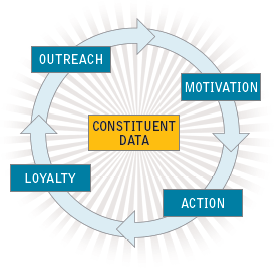Jan/Feb 2006
Convio Helps Organizations Break Away from the Traditional "Ask" into New Online Opportunities for Fundraising, Outreach and Building Constituent Loyalty
For some organizations, online fundraising means putting a "donate now" button on their Web site or asking for money via email. But this is just one aspect of what should be a larger strategy to identify new constituents, develop relationships with them and convert them to lifelong supporters. Since its beginning, Convio has based its software on a methodology called online constituent relationship management, or eCRM, which supports this larger strategy.
eCRM includes four phases:
- Outreach - Reach out to new and existing constituents
- Motivation - Motivate them with targeted, relevant content
- Action - Give them the tools they need to take action
- Loyalty - Build loyalty programs to drive ongoing support

Many organizations think of fundraising in the "Action" phase: Ask a person to give, and they make a donation. But, "Action" can mean much more.
Consider this example: An animal welfare organization wants to use email to get out inexpensive donation appeals immediately following animal rescues. The development director realizes, however, that the organization only has email addresses for 250 of its 20,000 donors and newsletter recipients.
Suddenly, "Action" takes on a new meaning. In this light, obtaining email addresses is key to the organization's ability to quickly help animals today and for years to come. The organization must take a couple of steps back and make "getting email addresses" the fundraising "Action" that they want to promote. To do this, the organization has to let new and existing constituents know that it needs their email address (Outreach) and give them a compelling reason to provide it (Motivation).
Using Convio, the organization can capture email addresses of site visitors with a quick registration form (first name, last name and email address only) on its Web site. The organization also can move its newsletter online, promoting the cost-savings of an email newsletter versus a print version and how it frees up more funds for its animal welfare work. This acts as an incentive for existing constituents and new site visitors to register.
"Motivation" also can take on new meaning. As the organization grows its email address file, it can use Convio tools to gather more information about constituents and build profiles of their individual interests, giving history, geographic location and more. For example, the organization can use Convio forms, surveys, message testing and click-through tracking to gather information about constituents as they register for events, sign up to receive email communications, or interact online in other ways with the organization. The organization then can use that information to create targeted email messages and Web content based on constituents' interests and past online interactions, increasing the likelihood that they will take action.
Once the organization begins putting Outreach, Motivation and Action steps in place, it can foster additional Loyalty. For example, the group can use its email newsletter as a donor loyalty tool, keeping donors informed about the organization's progress. The group also can send regular emails to update donors on how their dollars are being used. With Convio's Rewards tools, the organization also can assign points to specific constituent behavior — such as donating online — and allow constituents to redeem points for gifts — such as free memberships.
By applying the four phases of eCRM to its constituent communications, the animal welfare organization in this example can build the foundation for a strong, long-term online fundraising program. The group now can obtain email addresses of interested constituents as well as specific information about why they care about the organization's mission and what will motivate them to donate.
Convio continues to develop its software products based on the eCRM methodology so that any organization can use them to build a strong online fundraising program. In coming months, for example, the company will launch new online fundraising tools that help organizations further drive giving, such as using donation forms to gather additional information about donors.
As an organization uses these tools to continually gain insights about constituents, each online communication becomes more relevant to the constituent and more effective at motivating support. With this approach, any organization can successfully drive fundraising and other forms of support that are vital to its mission.